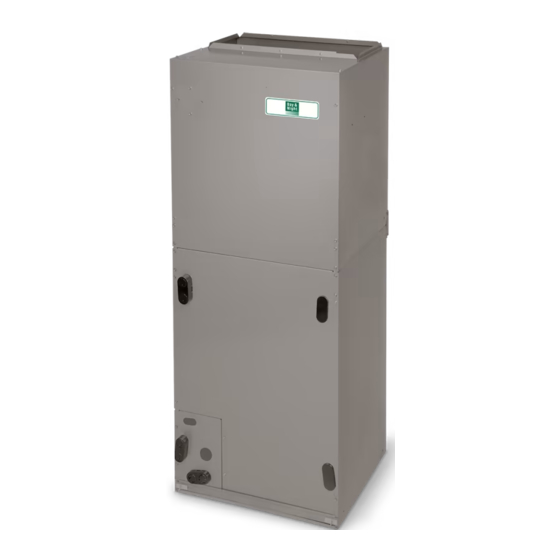Day and Night HCH9 Manual de instruções de instalação - Página 2
Procurar online ou descarregar pdf Manual de instruções de instalação para Bomba de calor Day and Night HCH9. Day and Night HCH9 16 páginas. R?410a two?stage split system heat pumps

INSTALLATION INSTRUCTIONS
SAFETY CONSIDERATIONS
Improper
installation,
adjustment,
maintenance, or use can cause explosion, fire, electrical
shock, or other conditions which may cause death, personal
injury, or property damage. Consult a qualified installer,
service agency, or your distributor or branch for information or
assistance. The qualified installer or agency must use
factory−authorized kits or accessories when modifying this
product. Refer to the individual instructions packaged with
the kits or accessories when installing.
Follow all safety codes. Wear safety glasses, protective
clothing, and work gloves. Use quenching cloth for brazing
operations. Have fire extinguisher available. Read these
instructions thoroughly and follow all warnings or cautions
included in literature and attached to the unit. Consult local
building codes and current editions of the National Electrical
Code ( NEC ) NFPA 70. In Canada, refer to current editions
of the Canadian electrical code CSA 22.1.
Recognize safety information. This is the safety−alert symbol
! !
When you see this symbol on the unit and in instructions
or manuals, be alert to the potential for personal injury.
Understand these signal words; DANGER, WARNING, and
CAUTION. These words are used with the safety−alert
symbol. DANGER identifies the most serious hazards which
will result in severe personal injury or death. WARNING
signifies hazards which could result in personal injury or
death. CAUTION is used to identify unsafe practices which
would result in minor personal injury or product and property
damage. NOTE is used to highlight suggestions which will
result in enhanced installation, reliability, or operation.
INSTALLATION RECOMMENDATIONS
NOTE: In some cases noise in the living area has been
traced to gas pulsations from improper installation of
equipment.
1. Locate unit away from windows, patios, decks, etc.
where unit operation sound may disturb customer.
2. Ensure that vapor and liquid tube diameters are
appropriate for unit capacity.
3. Run refrigerant tubes as directly as possible by
avoiding unnecessary turns and bends.
4. Leave some slack between structure and unit to
absorb vibration.
5. When passing refrigerant tubes through the wall, seal
opening with RTV or other pliable silicon−based caulk.
(See Fig. 1.)
6. Avoid direct tubing contact with water pipes, duct work,
floor joists, wall studs, floors, and walls.
7. Do not suspend refrigerant tubing from joists and studs
with a rigid wire or strap which comes in direct contact
with tubing.(See Fig. 1.)
8. Ensure that tubing insulation is pliable and completely
surrounds vapor tube.
9. When necessary, use hanger straps which are 1 in.
(25.4 mm) wide and conform to shape of tubing
insulation. (See Fig. 1.)
10. Isolate hanger straps from insulation by using metal
sleeves bent to conform to shape of insulation.
2
alteration,
service,
When outdoor unit is connected to factory−approved indoor
unit, outdoor unit contains system refrigerant charge for
operation with AHRI rated indoor unit when connected by 15
ft. (4.57 m) of field−supplied or factory accessory tubing. For
proper unit operation, check refrigerant charge using
charging information located on control box cover and/or in
the Check Charge section of this instruction.
IMPORTANT: Maximum liquid−line size is 3/8−in. OD for all
residential applications including long line.
IMPORTANT: Always install the factory−supplied liquid−line
filter drier. Obtain replacement filter driers from your
distributor or branch.
Check Equipment and Job Site
Unpack Unit
Move to final location. Remove carton taking care not to
damage unit.
Inspect Equipment
File claim with shipping company prior to installation if
shipment is damaged or incomplete. Locate unit rating plate
on unit corner panel. It contains information needed to
properly install unit. Check rating plate to be sure unit
matches job specifications.
Install on a Solid, Level Mounting Pad
If conditions or local codes require the unit be attached to
pad, tie down bolts should be used and fastened through
knockouts provided in unit base pan. Refer to unit mounting
pattern in Fig. 2 to determine base pan size and knockout
hole location.
For hurricane tie downs − contact your local distributor for
details and PE (Professional Certification), if required by local
authorities.
On rooftop applications, mount on level platform or frame.
Place unit above a load−bearing wall and isolate unit and
tubing set from structure. Arrange supporting members to
adequately support unit and minimize transmission of
vibration to building. Consult local codes governing rooftop
applications.
Roof mounted units exposed to winds may require wind
baffles. Consult the Low−Ambient pressure switch installation
instructions for wind baffle construction.
NOTE: Unit must be level to within ±2_ (±3/8 in./ft..) per
compressor manufacturer specifications.
Specifications subject to change without notice.
R−410A Split System Heat Pumps
Figure 1
Connecting Tube Installation
NOTE:
Avoid contact between tubing and structure
OUTDOOR WALL
INDOOR WALL
CAULK
INSULATION
THROUGH THE WALL
HANGER STRAP
(AROUND VAPOR
TUBE ONLY)
1" (25.4 mm)MIN.
SUSPENSION
INSTALLATION
LIQUID TUBE
VAPOR TUBE
JOIST
INSULATION
VAPOR TUBE
LIQUID TUBE
428 01 1703 01
